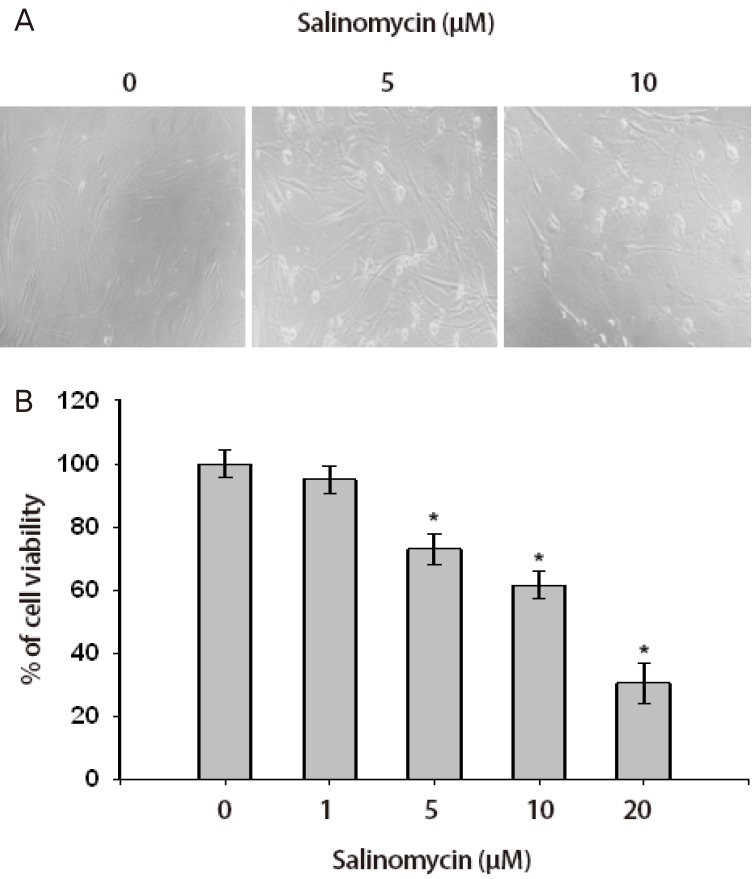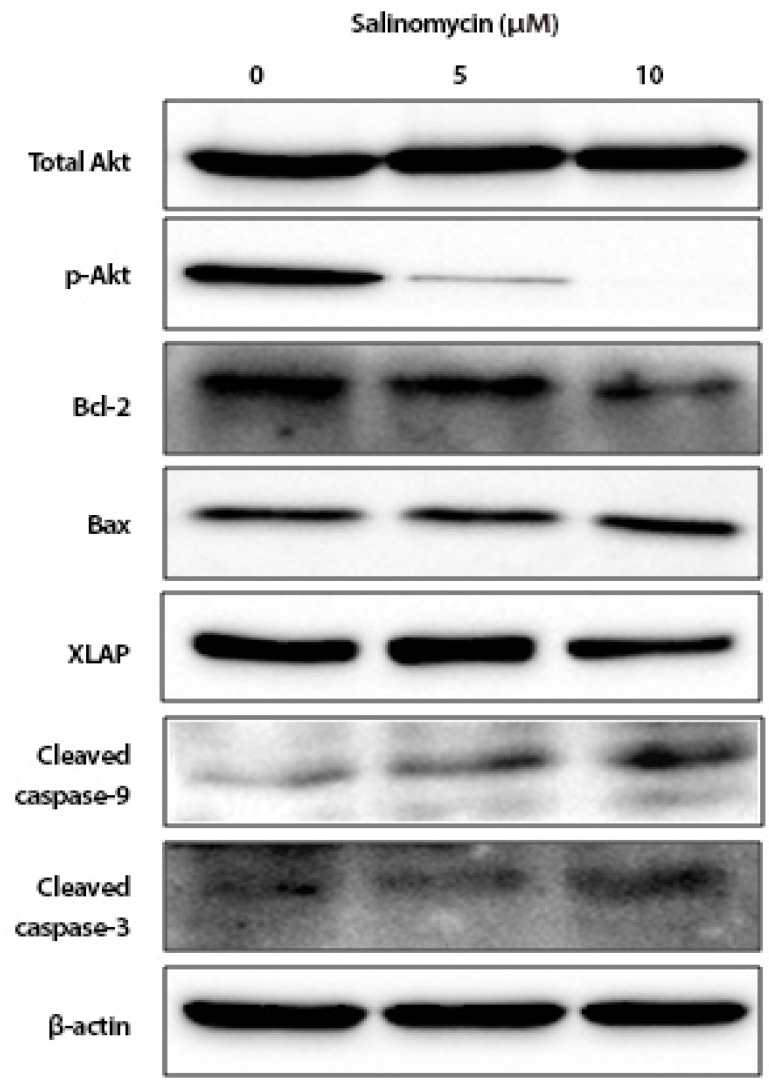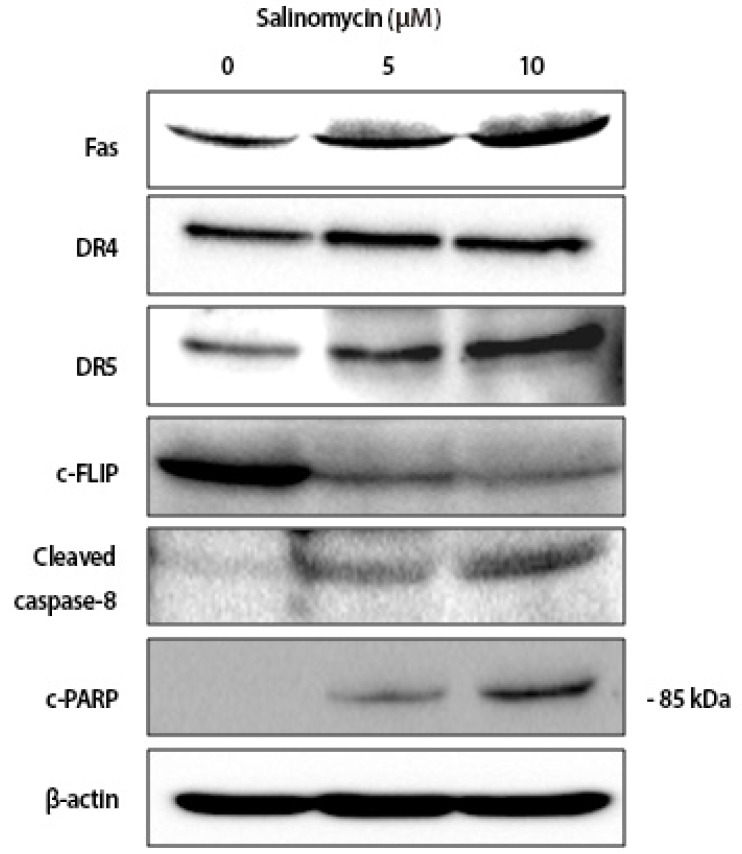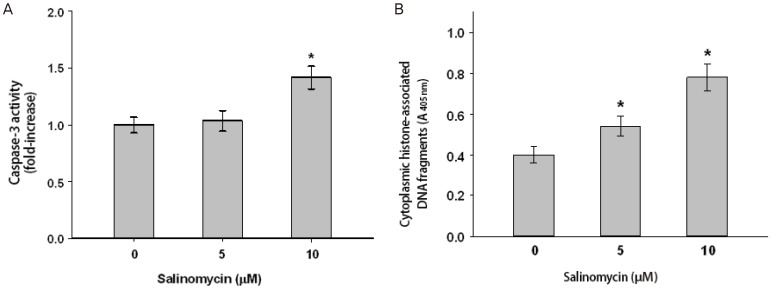Obstet Gynecol Sci.
2014 Nov;57(6):501-506. 10.5468/ogs.2014.57.6.501.
Salinomycin inhibited cell proliferation and induced apoptosis in human uterine leiomyoma cells
- Affiliations
-
- 1Institute for Cancer Research, Keimyung University School of Medicine, Daegu, Korea. chcho@kmu.ac.kr
- 2Department of Obstetrics and Gynecology, Keimyung University School of Medicine, Daegu, Korea.
- KMID: 2314017
- DOI: http://doi.org/10.5468/ogs.2014.57.6.501
Abstract
OBJECTIVE
The aim of this study was to investigate the anti-proliferative effect of the salinomycin in cell proliferation and apoptosis in primary cultured human uterine leiomyoma cells.
METHODS
Cell viability was measured by MTT (3-(4,5-dimethylthiazol-2-yl)-2,5-diphenyltetrazolium bromide) assay. Caspase-3 activity assay and DNA fragmentation assay were performed to determine the effect of apoptosis. The expression of apoptosis regulatory-related proteins was evaluated by western blot.
RESULTS
The cell viability and proliferation of uterine leiomyoma cells were significantly reduced by salinomycin treatment in a dose-dependent manner. DNA fragmentation assay results showed apoptotic cell death after salinomycin incubation. Salinomycin activated caspase-3, -8, and -9, causing apoptosis in uterine leiomyoma cells. Down-regulation of Bcl-2, XIAP, and FLIP with a concomitant increase in Bax, Fas, and DR5 were observed.
CONCLUSION
These results provided the first evidence that salinomycin induce both intrinsic and extrinsic apoptosis. Therefore, salinomycin may be a promising chemopreventive and therapeutic agent against human uterine leiomyoma.
Keyword
MeSH Terms
Figure
Reference
-
1. Buttram VC Jr, Reiter RC. Uterine leiomyomata: etiology, symptomatology, and management. Fertil Steril. 1981; 36:433–445. PMID: 7026295.2. Velebil P, Wingo PA, Xia Z, Wilcox LS, Peterson HB. Rate of hospitalization for gynecologic disorders among reproductive-age women in the United States. Obstet Gynecol. 1995; 86:764–769. PMID: 7566845.
Article3. Corbin A, Beattie CW. Ihibition of the pre-ovulatory proestrous gonadotropin surge, ovulation and pregnancy with a peptide analogue of luteinizing hormone releasing hormone. Endocr Res Commun. 1975; 2:1–23. PMID: 1097236.4. Johansen JS, Riis BJ, Hassager C, Moen M, Jacobson J, Christiansen C. The effect of a gonadotropin-releasing hormone agonist analog (nafarelin) on bone metabolism. J Clin Endocrinol Metab. 1988; 67:701–706. PMID: 2971080.
Article5. Friedman AJ, Harrison-Atlas D, Barbieri RL, Benacerraf B, Gleason R, Schiff I. A randomized, placebo-controlled, double-blind study evaluating the efficacy of leuprolide acetate depot in the treatment of uterine leiomyomata. Fertil Steril. 1989; 51:251–256. PMID: 2492232.6. Miyazaki Y, Shibuya M, Sugawara H, Kawaguchi O, Hirsoe C. Salinomycin, a new polyether antibiotic. J Antibiot (Tokyo). 1974; 27:814–821. PMID: 4452657.
Article7. Mahmoudi N, de Julian-Ortiz JV, Ciceron L, Galvez J, Mazier D, Danis M, et al. Identification of new antimalarial drugs by linear discriminant analysis and topological virtual screening. J Antimicrob Chemother. 2006; 57:489–497. PMID: 16415127.
Article8. Danforth HD, Ruff MD, Reid WM, Miller RL. Anticoccidial activity of salinomycin in battery raised broiler chickens. Poult Sci. 1977; 56:926–932. PMID: 605065.
Article9. Naujokat C, Fuchs D, Opelz G. Salinomycin in cancer: a new mission for an old agent. Mol Med Rep. 2010; 3:555–559. PMID: 21472278.
Article10. Mitani M, Yamanishi T, Miyazaki Y. Salinomycin: a new monovalent cation ionophore. Biochem Biophys Res Commun. 1975; 66:1231–1236. PMID: 1191289.
Article11. Gupta PB, Onder TT, Jiang G, Tao K, Kuperwasser C, Weinberg RA, et al. Identification of selective inhibitors of cancer stem cells by high-throughput screening. Cell. 2009; 138:645–659. PMID: 19682730.
Article12. Fuchs D, Heinold A, Opelz G, Daniel V, Naujokat C. Salinomycin induces apoptosis and overcomes apoptosis resistance in human cancer cells. Biochem Biophys Res Commun. 2009; 390:743–749. PMID: 19835841.
Article14. Elmore S. Apoptosis: a review of programmed cell death. Toxicol Pathol. 2007; 35:495–516. PMID: 17562483.
Article15. Dong TT, Zhou HM, Wang LL, Feng B, Lv B, Zheng MH. Salinomycin selectively targets 'CD133+' cell subpopulations and decreases malignant traits in colorectal cancer lines. Ann Surg Oncol. 2011; 18:1797–1804. PMID: 21267784.
Article16. Kim KY, Yu SN, Lee SY, Chun SS, Choi YL, Park YM, et al. Salinomycin-induced apoptosis of human prostate cancer cells due to accumulated reactive oxygen species and mitochondrial membrane depolarization. Biochem Biophys Res Commun. 2011; 413:80–86. PMID: 21871443.
Article17. Parajuli B, Lee HG, Kwon SH, Cha SD, Shin SJ, Lee GH, et al. Salinomycin inhibits Akt/NF-κB and induces apoptosis in cisplatin resistant ovarian cancer cells. Cancer Epidemiol. 2013; 37:512–517. PMID: 23545383.
Article18. Lu D, Choi MY, Yu J, Castro JE, Kipps TJ, Carson DA. Salinomycin inhibits Wnt signaling and selectively induces apoptosis in chronic lymphocytic leukemia cells. Proc Natl Acad Sci U S A. 2011; 108:13253–13257. PMID: 21788521.
Article19. Panka DJ, Mano T, Suhara T, Walsh K, Mier JW. Phosphatidylinositol 3-kinase/Akt activity regulates c-FLIP expression in tumor cells. J Biol Chem. 2001; 276:6893–6896. PMID: 11145953.
Article20. Bucur O, Ray S, Bucur MC, Almasan A. APO2 ligand/tumor necrosis factor-related apoptosis-inducing ligand in prostate cancer therapy. Front Biosci. 2006; 11:1549–1568. PMID: 16368536.
Article21. Kusunoki S, Kato K, Tabu K, Inagaki T, Okabe H, Kaneda H, et al. The inhibitory effect of salinomycin on the proliferation, migration and invasion of human endometrial cancer stem-like cells. Gynecol Oncol. 2013; 129:598–605. PMID: 23500085.
Article22. Fulda S, Debatin KM. Resveratrol-mediated sensitisation to TRAIL-induced apoptosis depends on death receptor and mitochondrial signalling. Eur J Cancer. 2005; 41:786–798. PMID: 15763656.
Article
- Full Text Links
- Actions
-
Cited
- CITED
-
- Close
- Share
- Similar articles
-
- Growth Inhibition of Human Uterine Leiomyoma Cells by Selective Estrogen Receptor Modulator
- Growth Inhibitory Effect of Resveratrol on Uterine Leiomyoma Cells
- Induction of apoptosis by Hibiscus protocatechuic acid in human uterine leiomyoma cells
- Cyclin-Dependent Kinase Inhibitor p27(Kip1) Controls Growth and Cell Cycle Progression in Human Uterine Leiomyoma
- Indole-3-carbinol and genistein inhibit growth of human uterine leiomyoma cells





